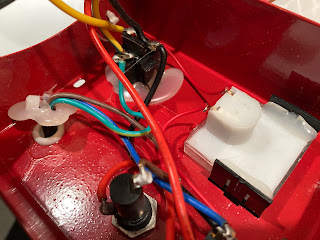Electromechanical pinball, bingo, arcade and amusement machine repair. EM pinball collector and lifestyle.
Wednesday, March 30, 2022
Satomi Miracle Can Can Arrangeball Video
Wednesday, March 23, 2022
Satomi Miracle Can Can Arrangeball Pictures
Satomi Miracle Can Can Arrangeball
More Pictures! Everyone likes pictures. They unintentionally, but inevitably, end up where pictures go to die... pinterest.
But first, I must admit, I made a mistake: One evening, I decided to clean the chrome frame around the arrangeball card... It turned out very nice.
Since I had a rag saturated in Autosol polish, I thought: "I wonder if the nails clean up?"
So I started cleaning a dark brass nail head and it shined up great.
Typical nails Before:
But then I realised: I have one clean nail in a sea of black nail heads. It looked ridiculous.
So basically I had to clean all the other nails on the game.
I'm glad of how it turned out and that I didn't damage the machine in the process.
BUT
Lesson learnt: Don't polish up a pachinko nail unless you want to do the whole game.
Now for the pictures.
Tuesday, March 15, 2022
Going 4 deep with Bally Capersville pinball
In this post I want to go deep with my favorite Bally electromechanical flipper game: Capersville
Bally Capersville was released in December 1966. It was designed by Ted Zale with artwork by Jerry K. Kelley. At the time Capersville was Bally's highest production electromechanical game, since Bally restarted it's pinball production in the late 50's, with 5120 units. The impressive production figure was surpassed in 1973 by Monte Carlo with 5254 units. Despite the high production figures, Capersville is a very hard to find game today, or at least hard to find here in Canada.
Capersville is a 3 ball multiball game. It was the Multiball follow up to 1963 Bally Star-Jet, being a 3 ball multi-ball game and incorporated the 4 step free ball escape assembly used in 1964 Bally Mad World. The grandmother of Bally Multiball games is Balls-A-Poppin.
Capersville combines gameplay elements of Star-Jet, with the two captive ball saucers at the top of the playfield and the 4 step free ball escape device of Mad World.
I think Capersville is the EM flipper pin game with the most features, or at least the most complex features ever released. Later I will focus on one feature: the 4 deep caper feature.
Capersville's artwork by Jerry K. Kelley is inspired by Jean-Luc Godard's 1965 film Alphaville:
The plot follows agent Lemmy Caution, on a mission to Alphaville. The mission: to repatriate or eliminate the architect of the Alphaville society. Alphaville is a technocratic society where everyone is controlled by the central computer Alpha 60. Everyone has a serial number and everyone must behave within the parameters of Alpha 60's logic. People who cannot adapt become outcasts in the society and are pressured to commit suicide or simply executed. People who do comply with alpha 60, but who for one reason or another act illogically, are executed publicly.
For the rest of the story, you have to watch the film.
Personally I love the movie. It's filmed like someone who draws building plans, or EM schematics, on the back of an envelope. Quick and dirty. A science-fiction dystopia. It's a noteworthy example of the French New Wave film movement and I find the film to have a powerful message in context to today's society. "Sauvez ceux qui pleurent" agent Dickson said.
In both the style and in the theme, we can see art elements that are picked up by Jerry Kelley from the film and it's many movie posters:
Pointy people: (A Jerry K. Kelley art style purloined by Christian Marche)
This one might be debatable, but the influence is definitely there... Alphaville was released May 5th 1965, Capersville was released December 1966 BUT Kelley's first pinball offering with pointy people art was Williams Pot-O-Gold released June 30th 1965. When was Pot-O-Gold's artwork conceived? I do not know... but it's less than two months apart:
A trio of bottom view:
Wednesday, March 9, 2022
Hot Glue Variable Transformer
I bought a Variable Transformer in early 2021. I got to the point in my life where I really needed one for my projects. I turned to ebay and got a the cheapest one available 79.99 canadian dollars delivered.
Had tons of fun with it since.
You can see me use it in this video where I tested an urban legend about bingo machines and variacs.
I use the transformer all the time to power my japanese domestic market 100V machines. I don't see the point of buying a dedicated step down transformer when I have the variac on hand.
One day I noticed that the power cord was loose in it's grommet where it enters the unit.
I didn't want to accidentally snag the power cord and rip the wires inside so I went in for a emergency bodge job.
Removed two screws that held the front panel to get inside the unit and discovered a lot of the components were held in by hot glue.
I replaced the hot snot grommet by a zip tie "grommet" that will at least stop the power cord from pulling out.
Actually, having a look inside the unit, the general build quality is a bit scheisse imo.
You get what you pay for.





















































